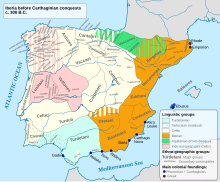Lusitans
The Lusitans are considered to be the ancestors of the Portuguese . They lived in the west of the Iberian Peninsula and initially consisted of a tribe who lived between the Douro and Tejo rivers . The name was later adopted by the Gallaekers or Galicians who inhabited the mountainous region north of the Douro, and other tribes, not only because they fought together against the Roman occupation, but also because they were culturally and ethnically very similar.
Origin of the Lusitans
The word Lusitaner is probably of Celtic origin, composed of Lus and Tanus , "tribe of Lusus". In Roman mythology , the siblings Lusus , a son or close friend of Bacchus ( Dionysus ), together with his sister Lisa (Lyssa), are the first parents of the Lusitans.
The language of the Lusitans is one of the Indo-European languages . At first the Lusitans were thought to be a sub-group of the Celtiberians . Modern authors assume, however, that they were based there before these. At times they were ruled by the Celtiberians before they reorganized. According to different views, the Lusitanian are therefore called Celtic or pre-Celtic and then keltisiertes classified people.
The thesis of the Celtic origin was mainly advocated by the French archaeologist Scarlat Sambrino , with reference to the Lusons who settled in the east of the peninsula , with whom they lived in the 6th century BC. Immigrated from the northwestern Alpine region (today Switzerland). This hypothesis connects the Lusitans with the Neolithic bell beaker culture . Historiographically, it is based in particular on the Ora maritima by Avienus from the 4th century AD, which in turn is based on documents from the 6th century BC. Chr. Based.
Lusitania
The areas that were initially settled by the Lusitans were probably the Duero valley and the Beira Alta region ; they stayed in the Beira until they were defeated by the Celts and other tribes. Then they spread to the Estremadura until the arrival of the Romans .
Culture
- The Lusitans lived in small single-storey houses, the floor plans of which were rectangular in their core area and round in the north.
- They made their clothes from wool and goat skin.
- They cultivated a bathing culture with hot steam and cold water baths.
- The Lusitans were monogamous .
religion
The Lusitans had numerous deities. Besides animals (especially goats) they also sacrificed prisoners to them.
Warfare
The Caetratii or Caetranann formed the core of the army. They were mostly armed with the caetra (round shield) and the falcata (swift cutting sword). Another common type of soldier were the Scutarii (Latin Scutum; shield). As a rule, they were more heavily armed and armed with so-called solifera ( javelins made of iron). The Scutarii fought in large, square formations. There were also war scythes , tridente (trident) and harpoons . The aristocrats ("Ambakaro") often fought as epones (cavalrymen).
Submission by the Romans
The Lusitans are named by Titus Livius in 218 BC. First mentioned as Carthaginian mercenaries. In 194 BC Chr. Struck Publius Cornelius Scipio Nasica , who was then praetor in Spain, was the Lusitanians at Ilipa . This was the beginning of disputes with varying degrees of success that dragged on for over 200 years.
178 BC After his victory over the Lusitans , the praetor Lucius Postumius Albinus celebrated a triumphal procession in Rome. On the other hand, they reached 155 BC. Under the command of Punicus (perhaps a Carthaginian general), then of Cesarus, the Rock of Gibraltar , where they were defeated by Praetor Lucius Mummius .
After this victory, Servius Sulpicius Galba brought about an armistice, which he broke when the Lusitans formed the new alliance. He murdered the ruling class and sold the survivors into slavery (150 BC), sparking a new rebellion (the so-called Spanish War ). This was led by Viriatus (* around 180 BC; † 139 BC), the most famous Lusitan. After his murder, however, she soon collapsed.
The Romans gained further victories over the Lusitans, under Decimus Junius Brutus Callaicus and Gaius Marius 113 BC. BC, but could only end their resistance after they had joined the troops of Sertorius . Marauding piles caused problems for the Romans who built fortified farmsteads until the turn of the century. Under the governors Antistius Vetus (27–24 BC) and Publius Silius Nerva (19–16 BC) the still marauding gangs were stopped.
See also
- Lusitania (Province)
- Prehistory of Portugal
- Timeline of the history of Portugal
- Lusitan warrior statue
Individual evidence
- ↑ dtv-Lexikon , Volume 14, Page 231 (Portuguese). Deutscher Taschenbuch Verlag, Munich 1971

